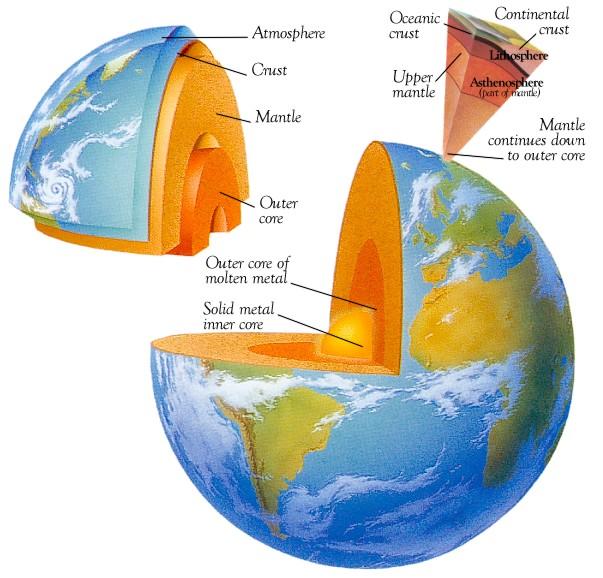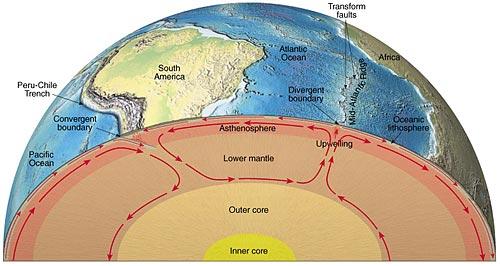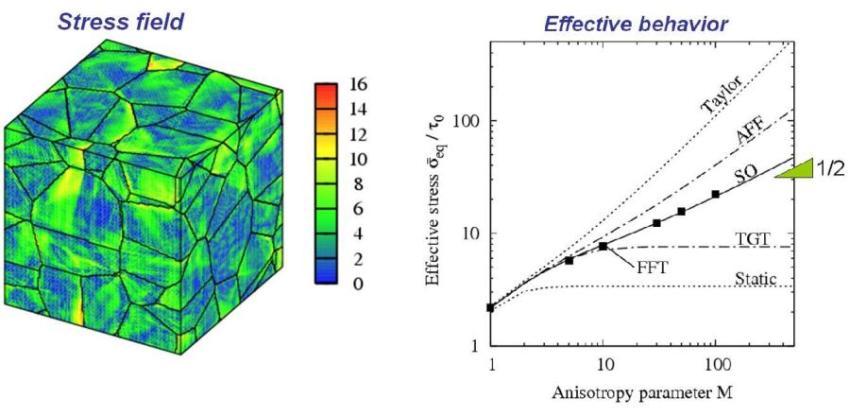Personal
Science topics
Semicrystallin polymers deformation
Prothesis
of anterior
cruciate ligament
Mantle rheology
Educational Resources
Earth's Upper Mantle Rheology
Projet financé par l'ANR MANTLE
RHEOLOGY
Partners: O. Castelnau (PIMM), P. Cordier (UMET), R.A. Lebensohn (LANL), S. Merkel (UMET), P. Raterron (UMET), W. Crichton (ESRF)
Earth's plate tectonics generates major haz(~30%)ards
for human societies (earthquakes, volcanic eruptions, tsunamis, etc.).
It is largely constrained by the rheology of the Earth upper mantle
(Figure 1, top 410 km) composed of polycrystalline
aggregates comprising olivine (~60 vol.%) mixed with
pyroxenes (~30%) and other minor phases such as garnets, and
possibly melt.

Figure 1: Earth cut (image by Colin Rose)
The complex behavior of this material comes from the extreme viscoplastic anisotropy at the crystal scale, so that the simultaneous activation of several deformation mechanisms (dislocation glide, dislocation climb, grain boundary diffusion ...) is probably necessary. Despite decades of experimental work, rheology of Earth mantle minerals is not well understood for several reasons:
- until recently, deformation experiments could not reach the pressure (~14 GPa) and temperature (~1500K) of the mantle;
- the pressure has a strong influence on dislocation mobility;
- data extrapolation to the extremely small in situ strain-rates (~10-15 s-1) requires a multiscale approach coupling several techniques and modeling;
- the extreme local anisotropy of all mineral phases requires the use of accurate homogenization models, which have almost never been applied in the context of deep Earth minerals.

Figure 2: in earth's mantle
The used polycrystal model will be based on mean-field homogenization methods (self-consistent scheme associated with the "Second-Order" linearization procedure of Ponte Castañeda). This second-order self-consistent approach is very efficient for minearl materials. The effective behavior predicted by this approach are compared with ensemble averages of the the fast Fourier transform FFT-based full-field solutions. This comparison show that the predictions obtayned by means of the second-order approach are in better agreement with the FFT-based full-field solutions (Figure 3).

Figure 3 Right: Stress field compute by FFT in olivine polycrystal
Left: Comparison between FFT-based full-field solutions (FFT) and several mean-field approaches (SO: second-order linearization; AFF: affine linearization; TGT: tangent lenarization) for different values of plastic anisotropic parameters M.

